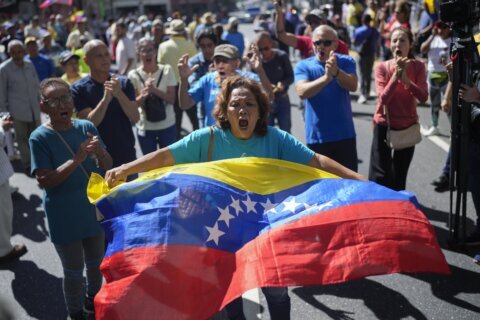SEOUL, South Korea (AP) — North Korea on Friday extended a provocative series of weapons tests by firing cruise missiles into the sea, as leader Kim Jong Un called for his military to step up war preparations and toured a shipyard.
South Korea’s Joint Chiefs of Staff said the U.S. and South Korean militaries were analyzing the North Korean launches into its western sea. It said South Korea’s military detected multiple missiles but it did not immediately provide a specific number or an assessment of their flights.
The launches, which were North Korea’s fourth round of cruise missile tests in 2024, came hours after state media reported that Kim reiterated his focus on strengthening his naval forces as he inspected unspecified naval projects at a shipyard in Nampho on the west coast.
Kim in recent months has emphasized efforts to build a nuclear-armed navy to counter what he portrays as growing external threats posed by the United States, South Korea and Japan, which have stepped up their military cooperation in response to Kim’s nuclear weapons and missile program.
U.N. Secretary-General Antonio Guterres is “increasingly concerned by everything we’ve seen in the last few weeks,” U.N. spokesman Stephane Dujarric said. “The secretary-general, for his part will continue to call for a de-escalation, a resumption of the diplomatic dialogue.”
North Korea’s official Korean Central News Agency did not specify when Kim visited Nampho. It paraphrased Kim as saying that the strengthening of the navy “presents itself as the most important issue in reliably defending the maritime sovereignty of the country and stepping up the war preparations.”
KCNA did not specify the types of warships are being built in Nampho, but said they were related to a five-year military development plan set during a ruling party congress in early 2021. During those meetings, Kim revealed an extensive wish list of advanced military assets, which included nuclear-powered submarines and nuclear missiles that can be launched from underwater.
During the inspection, Kim was briefed on the progress of his naval projects and remaining technological challenges and ordered workers to “unconditionally” complete the efforts within the timeframe of the plan that runs through 2025, KCNA said.
Kim Inae, a spokesperson for South Korea’s Unification Ministry, said it was the first time the ministry was aware of that state media reported on Kim Jong Un conducting a military inspection in Nampho. That could suggest an expansion of naval projects from the country’s eastern shipyard of Sinpo, which has been the North’s base for submarine construction. Kim didn’t provide a specific answer when asked whether Seoul believes the North is using Nampho for its efforts to build nuclear-powered submarines.
“By making military threats routine, North Korea is trying to create a sense of insecurity among South Korean people to undermine trust in their government and to attract international attention to build an atmosphere in which its demands must be accepted to resolve the crisis on the Korean Peninsula,” she said.
South Korea’s army said its special operation troops wrapped up a 10-day training with U.S. Green Berets on Friday in a region near the country’s capital, Seoul, in the allies’ latest combined military exercises. The countries in past months had staged larger drills, including trilateral exercises involving Japan.
Kim Jong Un also called for naval might on Sunday while inspecting a test of a new nuclear-capable cruise missile, the Pulhwasal-3-31, designed to be fired from submarines. The North also last month conducted tests of a long-range cruise missile, which it has described as nuclear-capable and can cover ranges of up to 2,000 kilometers (1,240 miles), which would potentially put U.S. military bases in Japan within reach.
While North Korea has demonstrated quick progress in expanding its lineup of land-based nuclear-capable missiles, experts say Kim’s naval ambitions may require significant more time, resources and technology breakthroughs. Most of its aging, diesel-powered submarines can launch only torpedoes and mines, and experts say Kim’s stated pursuit of nuclear-propelled submarines is largely unfeasible without significant external assistance.
North Korean military scientists and engineers in recent months have been making progress on Kim’s 2021 list of goals, testing for the first time last year a solid-fuel intercontinental ballistic missile, named Hwasong-18, which added to the North’s arsenal of weapons targeting the U.S. mainland.
The North on Jan. 14 also tested a new solid-fuel intermediate-range missile, which underscored its efforts to advance its weapons that could target U.S. assets in the Pacific, including the military hub of Guam.
The North also plans to launch three more military spy satellites in 2024 after sending its first one into orbit in November, as Kim has described space-based reconnaissance as crucial for monitoring U.S. and South Korean military activities and enhancing the threat of his nuclear-capable missiles.
Tensions on the Korean Peninsula are at their highest point in years, after Kim accelerated his weapons development to an unprecedented pace while issuing provocative nuclear threats against the United States, South Korea and Japan. The United States and its Asian allies in response have strengthened their combined military exercises and updated their deterrence strategies.
There are concerns that Kim, emboldened by the steady advancement of his nuclear arsenal and strengthened ties with Russia, would further ramp up pressure against his rivals in an election year in the United States and South Korea. Experts say Kim’s long-term goal is to force the United States to accept the idea of the North as a nuclear power and negotiate security concessions and sanctions relief from a position of strength.
While most analysts downplay Kim’s threats of war, some say there’s a possibility that he can attempt a direct military provocation he can likely contain without letting it escalate into a full-blown conflict. One of the potential crisis points is the disputed western sea boundary between the Koreas, which had been the site of several bloody naval skirmishes in past years.
___
Follow AP’s Asia-Pacific coverage at https://apnews.com/hub/asia-pacific
Copyright © 2025 The Associated Press. All rights reserved. This material may not be published, broadcast, written or redistributed.






